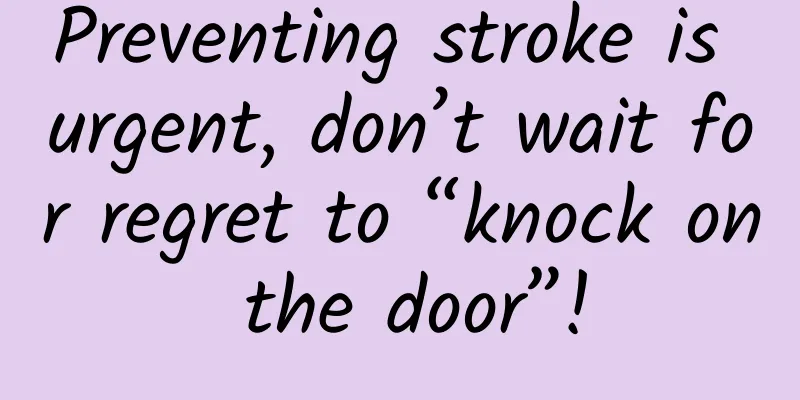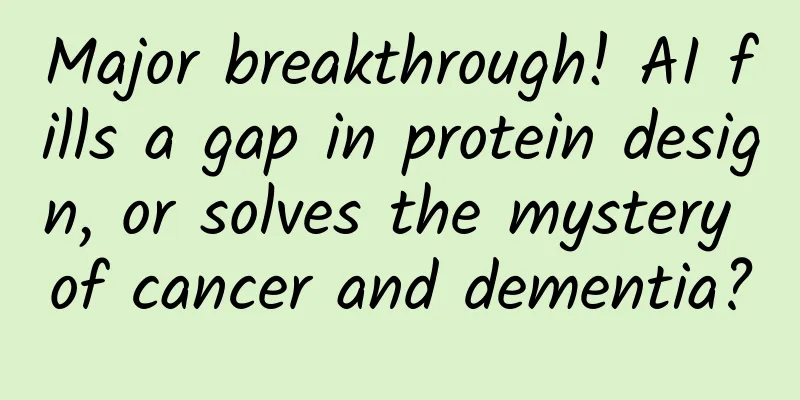Preventing stroke is urgent, don’t wait for regret to “knock on the door”!

|
Author: Xu Wang, Zhujiang Hospital, Southern Medical University Liao Rongrong Zhujiang Hospital of Southern Medical University Reviewer: Fan Yuwen, Chief Physician, Chenzhou Traditional Chinese Medicine Hospital, Hunan Province Chen Hanxi, Chief Nurse, Guangdong Provincial People's Hospital Stroke, also known as "stroke", is an "invisible killer" that threatens the health of modern people. It often comes quietly when people are unprepared. Unhealthy lifestyles such as staying up late, alcoholism, and high blood pressure are becoming catalysts for stroke. There may be frightening real cases around us, such as young men who suffer from strokes because they often stay up late to work overtime and have alcoholism habits, or young working mothers who suffer from sudden strokes due to long-term life pressure, busy work, lack of regular work and rest and exercise, or elderly people with chronic hypertension who have not been able to effectively control their hypertension for many years and eventually suffer from strokes... One by one, all of them show us the high incidence and horror of stroke! Figure 1 Copyright image, no permission to reprint Today we will discuss in detail the risk factors of stroke and provide you with prevention and first aid knowledge. We hope that every reader can enhance their awareness of stroke prevention and protect their own health. 1. What is stroke? Stroke is divided into two categories, ischemic stroke and hemorrhagic stroke. Ischemic stroke, also known as "cerebral infarction", is caused by blockage of cerebral blood vessels, resulting in insufficient blood supply to a certain area of the brain, which in turn causes brain tissue damage. Hemorrhagic stroke refers to the rupture of cerebral blood vessels, blood entering the brain tissue, causing brain tissue damage. The latter usually progresses more rapidly and is more harmful. Stroke can cause various consequences, such as limb paralysis, speech disorders, dysphagia, and even death. Therefore, stroke prevention is of vital importance. 2. What are the main risk factors for stroke? 1. Hypertension: This is the main risk factor for stroke. Long-term hypertension can damage blood vessel walls and significantly increase the incidence of stroke. Figure 2 Copyright image, no permission to reprint 2. Improper management of chronic diseases: If chronic diseases such as hyperlipidemia and diabetes are not properly controlled, it will aggravate vascular damage, lead to blood circulation disorders, and increase the risk of stroke. 3. Unhealthy lifestyle: staying up late, lack of exercise, unhealthy diet, etc. can cause obesity, high blood pressure and high blood lipids, indirectly increasing the risk of stroke. 4. Smoking and alcoholism: Smoking accelerates arteriosclerosis, and alcoholism causes high blood pressure, both of which can increase the risk of stroke. 5. Psychological stress: Long-term psychological stress can cause blood pressure fluctuations, increase heart rate, increase cardiovascular burden, and thus increase the risk of stroke. 6. Age and family history: As age increases, blood vessel elasticity decreases and the risk of stroke increases. In addition, the incidence rate is also higher in people with a family history of stroke. 3. How to determine the occurrence of stroke? Stroke often occurs suddenly and is severe. Knowing the early symptoms and identifying them in time can buy patients valuable time for treatment. The commonly used method for diagnosing stroke is the "FAST" rapid identification method. F (Face): Observe whether the face is sagging or the mouth is crooked. A (Arms): Raise both arms and check if one side is weak and drooping. S (Speech) Language: Say a simple sentence to see if you have slurred speech or difficulty expressing yourself. T (Time): If you experience the above symptoms, call emergency services immediately. Figure 3 Copyright image, no permission to reprint IV. Emergency treatment of stroke: treatment within the golden time The emergency response window for stroke is very short. Usually, intravenous thrombolytic therapy within 3 to 4.5 hours after onset can minimize brain damage. Therefore, rapid identification of stroke and timely medical treatment are key. The first aid steps are as follows. Call emergency services immediately: time is of the essence, and every minute of delay can increase brain damage. 1. Stay calm and avoid moving: The patient should lie flat with the head slightly elevated to keep the airway open. 2. Fasting and abstention from water: After a stroke, patients may experience difficulty swallowing and should abstain from food and water to avoid suffocation due to accidental aspiration. 3. Seek medical attention as soon as possible: After arriving at the hospital, the doctor will perform a CT or MRI examination based on the patient's condition to determine whether it is an ischemic stroke or a hemorrhagic stroke, and take immediate treatment measures. 5. Master the six key points to stay away from stroke Stroke is preventable, and the probability of its occurrence can be greatly reduced by changing unhealthy lifestyles and managing health risks. 1. Control blood pressure Hypertension is the primary risk factor for stroke. It is very important to measure blood pressure regularly and keep it within the normal range. You should also eat a light diet and reduce salt intake. 2. Quit smoking and limit alcohol consumption Smoking and excessive drinking can seriously damage blood vessel health and increase the risk of arteriosclerosis and stroke. Quitting smoking and limiting alcohol consumption can not only help prevent stroke, but also improve overall health. 3. Eat a balanced diet Healthy eating habits can effectively prevent stroke. It is recommended to consume more foods rich in dietary fiber, low in fat and low in cholesterol, such as vegetables, fruits, whole grains, etc., and reduce the intake of red meat and processed foods. 4. Exercise Doing at least 150 minutes of moderate-intensity exercise per week (such as brisk walking, cycling, etc.) helps maintain cardiovascular health. It is suitable for normal people and most people with chronic diseases. However, if you have heart disease or severe respiratory diseases, you need to consult a doctor and make individual adjustments to the amount and intensity of exercise to ensure safety and effectiveness. Figure 4 Copyright image, no permission to reprint 5. Manage emotions and stress Long-term excessive stress can lead to high blood pressure and easily induce stroke. Relieving stress and maintaining mental health through meditation, yoga, etc. are also important for preventing stroke. 6. Regular medical check-ups For people with chronic diseases such as hypertension, diabetes, and heart disease, regular physical examinations are very important, as they can detect potential health problems in a timely manner and intervene. Although stroke is fierce, it is not unpreventable. By improving lifestyle and strengthening health management, we can effectively reduce the incidence of stroke. Only by understanding the risk factors and taking preventive measures can we protect our brain health to the greatest extent. Let us act quickly to protect our health and stay away from the threat of stroke. |
<<: Skin: The "super shield" that protects the human body
>>: Can washing your face with alternating hot and cold water shrink pores?
Recommend
Menstrual bleeding is bright red
The color of menstruation generally contains a li...
Top 10 Nuts That Pregnant Women Should Avoid
There are no top ten nuts that are taboo for preg...
What causes labia erosion?
Labia erosion is generally caused by vulvitis. So...
Can I eat sea bass during menstruation?
Women need to pay special attention to their diet...
International Stomach Protection Day丨This type of cancer has a high incidence and mortality rate, how to prevent it?
Today (April 9) is International Stomach Protecti...
When is it easiest for a woman to get pregnant after her menstrual period?
A woman's menstrual cycle is closely related ...
"Health from eating" series | National Nutrition Week: @The elderly around you, this dietary advice is very important
Recently, a review article published in the Briti...
What's wrong with my period coming ten days early?
Menstruation is actually menstruation, and menstr...
Gynecological examination epithelial cells 1 plus
Gynecological diseases are one of the biggest tro...
What are the symptoms of menopausal pain
When women reach around 40 years old, they will e...
Why are giraffes not part of the deer family? How do giraffes sleep?
Giraffes are the tallest mammals in the world, wi...
What to do when your breasts swell during menstruation
The menstrual period for women is actually very a...
Want to eat all the crayfish? First figure out: where are you eating crayfish from?
Recently, although the temperature has repeatedly...









